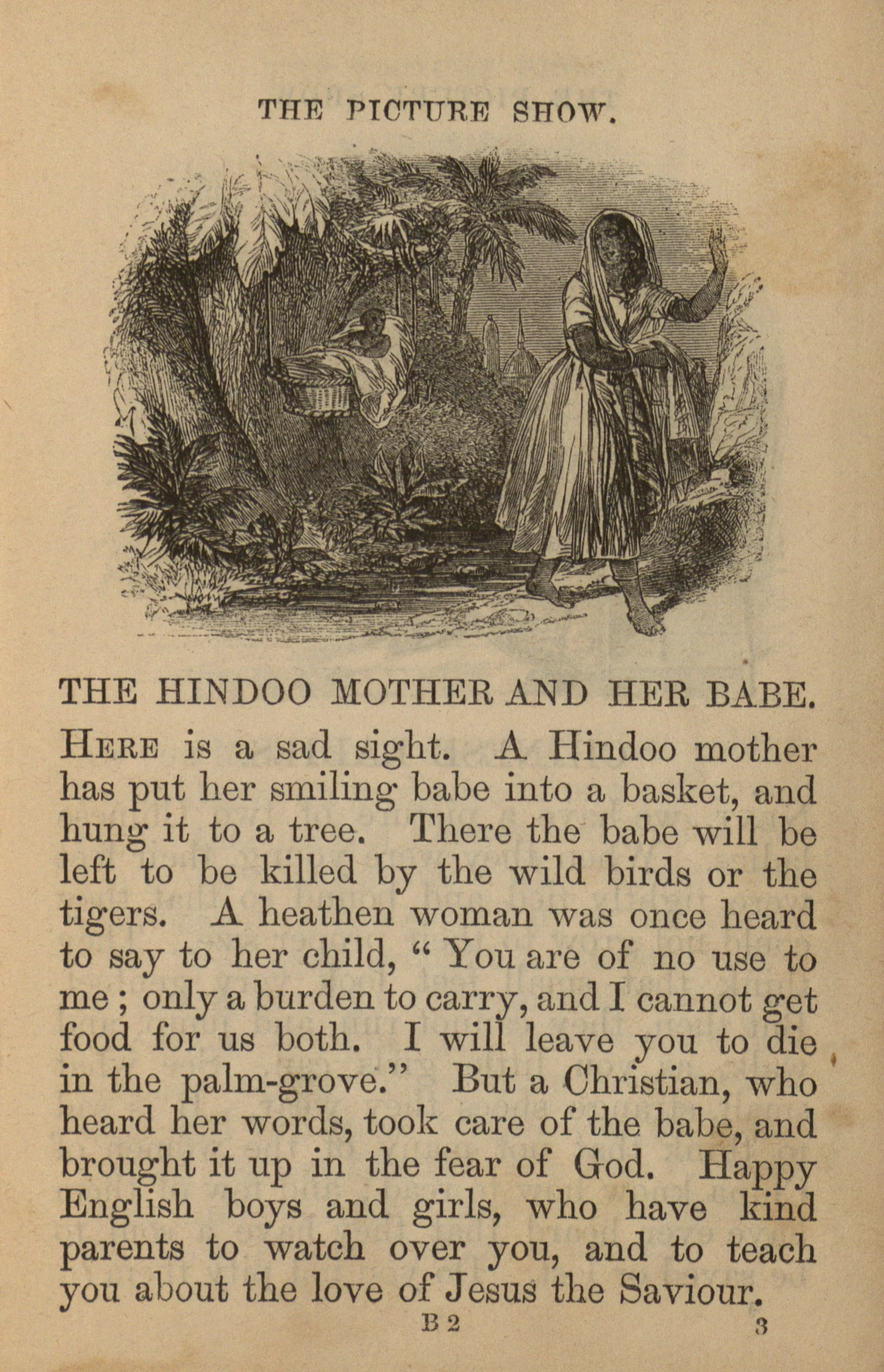Exhibit
Creation Date
1800
Height
7 cm
Width
7 cm
Medium
Genre
Description
In this image, a Hindu woman abandons her baby in a basket hung from a tree. The illustration serves as a counterexample to the moral lesson of the accompanying text, while also serving as an example of the absence of "Christian" virtue in "pagan" cultures.
A Hindu woman, wearing a short-sleeved dress, walks away from the basket in which she has placed her baby. A scarf is draped over her head, and she holds one end in her left hand. Her right hand is raised in a wave-like gesture, and her head is half-turned to the left, back towards the basket. She is smiling. The basket is suspended by a rope from the limbs of a tree with palm-like leaves. The oval basket is lined with white cloth in which the baby is wrapped up to his chest, his arms atop the cloth. Plants with large, exotic leaves grow at the base of the tree, which appears to be at the edge of a dark forest. In the background, the dome and minaret of a mosque are visible, as well as a palm tree.
Images like this one were intended to teach children proper attitudes concerning Christian duties, class responsibilities, and the inferiority of non-Europeans.
The clear allusion to Moses in an image otherwise occupied with depicting a colonial setting and situation shows the growing acceptance of visual associationism in overtly morally or religiously instructive contexts. Many conservative children’s authors, such as Sarah Trimmer and Hannah More, disagreed with the use of associationism in images for children, particularly in the case of religious subject matter; they feared that the mixed nature of these associations might misfire and create detrimental connections (Ruwe 8). Whatever texts in conservative children’s literature might show, however, their images reveal a less firm stance on association. In this image, the baby hanging in its basket—with its unmistakable connection to the baby Moses found in the rushes—creates an association between the exotic and subtly shocking scene and the biblical tale. Since the Religious Tract Society also produced illustrated bible stories for children, the image serves not only as a connection between the nature of the heathen child and the great Old Testament leader, but also as a link between the two types of publications put out by the RTS (Grenby 33). Since the tracts were distrubted for pennies each, it seems tenuous to claim that this is a marketing ploy; however, it does indicate a potential, visual project on the part of the RTS to create ties between the explicitly biblical and the morally instructive.
As part of the “picture show” section of the book, this image recalls the peepshows popular in the late eighteenth- and early nineteenth-centuries. Early peepshows consisted of large boxes with a small hole on one side through which viewers looked at images. These images were three-dimensional, and usually depicted cities, battles, landscapes, or biblical events (Ogata 69). At fairs and gatherings, peepshow men would accompany the images with spoken narration; here, the extensive labels serve the same purpose. By the early nineteenth century, peepshows made of paper—"foldout paper construction with printed scenes and a peephole"—were widely available and fairly inexpensive. They evoked the grandness of the expositions they recreated and the magic of exotic scenes; peepshows were “not only a way to inculcate lessons of nationalism and principles of taste and consumption, but also provided a form of successful entertainment" (Ogata 70). The series of images in which "A Hindoo Woman" appears is labeled and arranged to deliberately invoke the peepshow aesthetic, and shares similar aims. As the reader flips through this first section of the book, the text is presented with images from a variety of exotic scenes; consequently, the visual experience created by this collection mimics the sense of wonder and surprise elicited by the more complicated and visually rich peepshows.
Collection
Accession Number
CA 10362
Additional Information
Bibliography
Campbell, Colin. "Bewick, Thomas." Grove Art Online. Oxford Art Online. Oxford UP, 18 Jan. 2006. Web. 6 May 2009.
Carpenter, Humphrey and Mari Pritchard. “Religious Tract Society.” The Oxford Companion to Children’s Literature. Oxford: Oxford UP, 1999. Print.
Grenby, M.O. “Adults Only? Children and Children's Books in British Circulating Libraries, 1748-1848.” Book History 5 (2002): 19-38. Print.
Kinnell, Margaret. “Scepterless, Free, Uncircumscribed? Radicalism, Dissent and Early Children’s Books.” British Journal of Educational Studies 36.1 (1988): 49-71. Print.
Ogata, Amy F. "Viewing Souvenirs: Peepshows and the International Expositions." Journal of Design History 15.2 (2002): 69-82. Print.
Ruwe, Donelle. "Guarding the British Bible from Rousseau: Sarah Trimmer, William Godwin, and the Pedagogical Periodical." Children's Literature 29 (2001): 1-17. Print.
Thompson, Hilary. "Enclosure and Childhood in the Wood Engravings of Thomas and John Bewick." Children's Literature 24 (1996): 1-22. Print.

